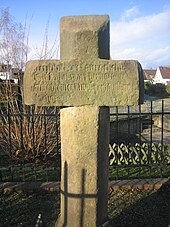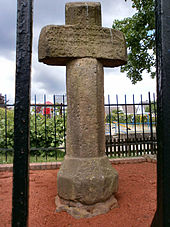Kaiserkreuz (Kleinenglis)
The Kaiserkreuz von Kleinenglis is a Gothic monument of national historical importance in the Borken district of Kleinenglis in the north Hessian Schwalm-Eder district .
The cross
The sandstone cross with its stone base, about 2.10 m high, was made in the 15th century by an anonymous sculptor in memory of the Count Heinrich VII von Waldeck and his cronies Friedrich III. by Hertingshausen and Konrad (Kunzmann) von Falkenberg murdered Duke Friedrich of Braunschweig and Lüneburg . It is on Hundsburgstrasse at the western end of Kleinenglis. The cross itself is 144 cm high, 84 cm wide and 35 cm thick. The continuous trunk is octagonal in cross-section up to the head . The cross piece of the continuous arms bears an inscription made of Gothic minuscules , which, however, has not yet been deciphered.
The cross is probably not an atonement, but a memorial cross. King Ruprecht's verdict on the two murderers Friedrich von Hertingshausen and Konrad von Falkenberg mentioned nothing of the erection of a cross under the atonement conditions.
The cross was overturned towards the end of the 17th century and only erected again and surrounded with a fence in 1712. Pieces were later cut off to be worn as amulets . Because there was a wagoner belief that the cross was held together by an inner mysterious force, Liège wagoners wanted to test its durability and wobbled until it fell over; the mysterious forces were wooden dowels that had provided a certain elasticity. In 1790 the cross was restored and has remained in place to this day.
The murder
Duke Friedrich had been proposed at the Fürstentag in Frankfurt on May 22, 1400 as a possible opponent against the largely unloved German King Wenzel , but the Archbishop of Mainz , Johann II of Nassau , and the two other ecclesiastical electors favored the Rhineland Count Palatine Ruprecht, so that the parties left Frankfurt in disagreement. Friedrich's companions included his brother Bernhard von Braunschweig, Elector Rudolf von Sachsen, the Counts of Schwarzburg and Barby, and the Bishop of Verden. The tour group reached the village of Kleinenglis on June 5, 1400, Pentecost Sunday. There she was attacked by around 200 gunmen from Count Heinrich VII von Waldeck and his cronies. In the bitter skirmish that followed, Duke Friedrich was killed. The provost of Verden, Heinrich, also lost his life. Since the murderers were all Mainz feudal men and Heinrich von Waldeck was Mainz chief magistrate in Niederhessen, the suspicion of instigation fell on the Archbishop of Mainz, Johann. Wenzel was allowed to keep his crown until August 20, 1400, before he was deposed and replaced by Ruprecht.
Wilhelm Dilich's historical report
In his Hessische Chronica of 1605 Wilhelm Dilich wrote , albeit not entirely accurate, because Friedrich was by no means newly elected emperor:
"Alß also in by means of the unworthy Keizer Wenceslaus appalled by the Elector of the Reich and Friedrich H. Magni with the chain son Hertzog zu Braunschwig in his place as Keizer, but the Bishop zu Meintz, born from Nassau, he has against through the Count of Waldeck / and several Hessians from the nobility, including those of Falckenberg and Hertingshausen, hold onto the newly-elected Keyser and let them slain by Engeliss: and there is still a high stone creutz at the place where the deed performed. "
Different interpretation
According to another declaration, Heinrich von Waldeck had a debt claim of 100,000 silver marks on the Duke of Braunschweig, which he had not yet paid despite all warnings. The attack should therefore only have resulted in Friedrich's capture, but ended fatally because of the bitter resistance of the attacked. However, the amount mentioned is incredibly high for those times.
Individual evidence
- ^ Wilhelm Dilich: Hessische Chronica . Faithful facsimile print. Ed .: Wilhelm Niemeyer. 1st edition. Bärenreiter-Verlag, Kassel 1961.
- ↑ Atonement Crosses & Mordsteine (Ed.): Kleinenglis . ( HTML [accessed December 2, 2008]).
Web links
- History of the Imperial Cross
- Kaiserkreuz von Kleinenglis
- http://www.suehnekreuz.de/hessen/kleinenglis.htm
literature
- Heinrich Riebeling, Stone Crosses and Cross Stones in Hesse , 1977, No. 4921.1
- Heinrich Riebeling, Historical legal marks in Hesse , 1988, appendix: additions to "Stone Crosses and Cross Stones in Hesse", P.XIII, No. 4921.1
Coordinates: 51 ° 4 ′ 19.1 ″ N , 9 ° 14 ′ 55.7 ″ E

